
01 Jun The Sound of an Old Forest
Master Luthier Kevin Kopp came to us through the best journalist working in America, Richard “Dick” Manning. Manning, writing about music while learning to play the guitar, approaches it the way he approaches everything: with an inexhaustible curiosity and intelligence — two qualities often inextricably linked. The story of The Montana Project’s guitar is not about Manning, however. It’s about Kevin Kopp — well, it’s actually about America — but the catalyst for the project occurred in Missoula when Manning, almost shyly, brought out a guitar he’d recently purchased. He held the guitar with a mix of reverence and doubt that communicated the instrument’s value and rarity far better than words could.
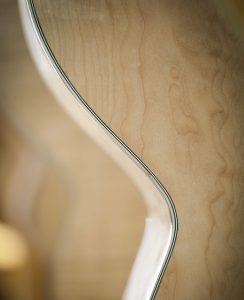
When he handed it to me, I felt immediately dizzy. It was light, but crackled with strength, vigor. This is going to sound crazy, but it seemed to be wanting to speak. Remember that great Guy Clark song, “The Guitar”?
This was totally like that. It didn’t just have a soul, it seemed to be desirous of finding another’s, or others’. It was a soul-hunter. I held it for only a moment, then delivered it back to its owner. Manning’s fingers brushed the strings, and the sound that came out was light and bright, sharp and clean, and something more, something ineffable. Manning saw my expression, smiled and nodded, then took the guitar back to his studio, again as if carrying an infant back to its crib. Sweet dreams, little one, some day you’re going to grow up to be something.

Rick Bass stands amidst old larch and cedar in the Yaak Valley of Montana. These two species generally aren’t found shoulder to shoulder.
But enough about Manning. I meant to be writing about Kevin Kopp. By now you’ll understand that to live in Montana is to risk being perpetually gobsmacked by digressions. There’s so much bounty; so much beauty. How does one avoid existing in a state of constant tizz? (Surely the only answer is to slow down.)
Kevin Kopp worked for the legendary Gibson Guitars, in Bozeman, Montana, for 10 years before going out on his own to make what’s called, with understatement, “high-end” guitars. The wait for a Kopp guitar can take years due to the painstaking craft and demand. Some of his clients include virtuoso guitarists Darrell Scott and Leo Kottke.
In the small world that is so commonplace in Montana, I learned that Kopp and his partner are building a cabin in the Yaak, where I live. So I went to him with an idea.
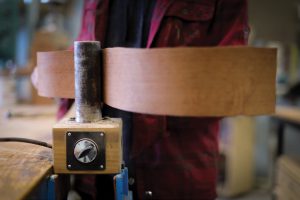
Wood is shaped to sing in Kevin Kopp’s guitar shop.
Manning said that Kopp’s rich, bright, hot, fast, clean guitars — picture a 1965 Ford Mustang — usually had a tight-grained spruce top: That was what gave it its primary soul. Manning also told me long ago, as had other musicians subsequently, that wood has a memory. That in transmitting the physical vibrations that create sound, the wood continues trembling, vibrating, long after the song has been played; it comes a little easier, a little richer, a little stronger, as the sound travels in a wave within the wood, beneath the musician’s fingers. That it’s like the neural pathways in our brains. That it’s like bushwhacking at first, but then, somehow, a way, if not always a worn path, becomes clear. The sound moves from the stillness and darkness — waiting — into motion and light.
Violins from a thousand years ago still have a memory. The instrument becomes a partner with the song. The musician — interpreter, mediator — adjusts the song slightly to fit the instrument. In this way, the instrument creates the song as much as the artist. And the tree is the parent of the instrument, the first-dreamer. And the forest is the instrument’s family. And when the music enters us, we become the tree’s family.

Noelle Huser of the band Bluest introduces the guitar to its first elevator ride.
Because the music remains in the wood forever, a fine instrument is a museum, or a library, for sound. For songs. Which is to say, for desire, celebration, lamentation. For passion.
You can feel that in a Kopp guitar; it quivers with that which is yet to come. That which the wood desires. That which the tree — and no tree exists without a forest — desires. A tree holds within an infinitude of songs, just beneath the canopy, beneath the overstory — waiting. Maybe we will hear them, or maybe not. A tree need not be made into a guitar to be heard. But all trees contain, in that singular fingerprint of light and darkness, growth and sleep, a sound that’s waiting to roll through the world — some quick and hot and fast and bright, others low and slow.

Biehl teaches the new guitar some very old songs.
(Scientists have informed us that the buzzing of bumblebees has evolved to emit frequencies that — use whatever verb you wish — encourage, facilitate, seduce blossoms to open for pollination. What’s not yet been measured or discovered, but which I imagine is equally true, is that the blossom or blossoms send out an unseen map — I picture invisible contour lines on an invisible map — which calls for a certain arrangement of vibrations or frequencies of sound and shapes, the sounds of the bumblebees. In this, the silent flower is sometimes the instrument more than the bee, with its clamant sound.)
But I’ve digressed, yet again, in widening concentricity around the idea, which was this: that Kopp make a guitar from a piece of ancient spruce from the Yaak. Many of his instruments are sourced from the Yaak, I was to find out. But I had a particular forest in mind, if not yet the very tree.
For almost six years now, a small group of us in the Yaak has been working to stop a proposed timber sale, the so-called Black Ram project, which covers significant territory and would cause some trauma and damage to the public lands — our national forests, which are owned equally.
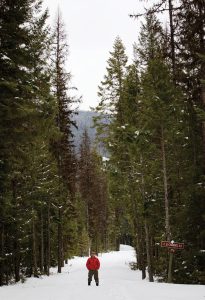
It’s difficult not to feel dwarfed — happily and rightly so — by the sound and stature of an old forest.
All beings, the human and non-human, breathe the same air and rely upon the same fresh water. (Which, increasingly, has to be filtered, modified, and treated.) In Montana, our state constitution is unique among those of the 50 not-entirely-united-states, in that it guarantees Montanans the right to clean air and clean water. It’s one of the most democratic assertions I know. It’s an implicit acknowledgement of the rights of nature, as well as those of Montana’s residents.
About the forest: it’s old. It’s what’s called a primary forest — one of the rare ones that remain in that hard-cut valley. How old? There are giant mother larch trees scattered throughout the ancient forest that are between 600 and 800 years old. Many of the younger cohorts — spruce and subalpine fir — are a mere 315 years old.
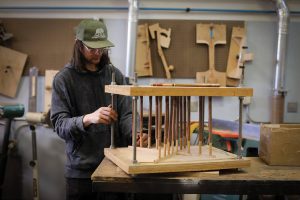
Kopp’s assistant, Andy Armstrong, possesses a less-is-more aesthetic. Kopp says the mother of pearl inlay was “the most difficult I’ve ever done.”
But the real show-stopper is the forest floor. The carcasses of fallen giants are sinking slowly into the orange mulch and luxuriant rot of their predecessors, their crumbly carcasses soggy with the amount of water they absorb. The entire forest floor is a moss-clad sponge. Carcasses atop carcasses — carcasses all the way down. It’s like the Louvre for ancient trees. It’s a cathedral.
What’s even more amazing is that trees grow slowly this far north, so it takes them even longer to get this big, with the towering overstory in perfect communication between soil and sky. Whenever one of the giants leans slowly over, its roots and its weight finally too large for the swampy microsite in which it grows, it creates a lane for a slash of light down into the ancient forest. Just a narrow slash, like a singular note of music.

New seedlings sprout in that seemingly random stripe of light, growing from the hearts of the rotting ancients.
The forest is at a high elevation, way up in the northwest corner of the most northwestern valley in the state. The old forest is right on the Canadian line; it spills over into Canada.
The U.S. Forest Service has plans for this ancient scientific marvel — a relic from the last phase of global warming, one that is prospering, even in this phase. The agency’s plans are to eradicate nearly 800 acres of the old forest. The disruption has already begun with a 200-foot-wide road and lane cleared straight to the proposed units. Giants at the edge of the clearcut are already toppling, due to the new wind tunnel that’s been created by that wide clearing.
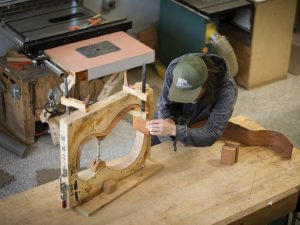
From one of those wind-tossed immense spruce, we cut a firewood-sized length of ancient spruce — like taking a vertebrae from a 150-foot-long whale — and wheelbarrowed it back out and delivered it to Kopp in Bozeman, keeping the wood moist with sprinklings of water along the way, as if in a baptism.
It took him a year. “Whoever plays it first needs to be good,” was all he said. “To help teach her what she can do.” Opening up, they call it. I knew who to ask: Nate Biehl, Caroline Keys, Gibson Hartwell. “We didn’t play it,” they said of the experience, “it played us.” I listened to it — exquisite, bright, strong, clear — and saw how they lost all sense of time while playing her.
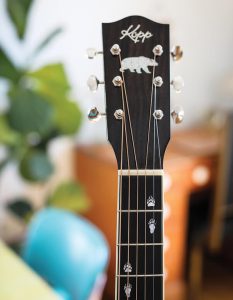
Can a tree save a forest? Yes. We’ll ask musicians from all over the country to play songs celebrating resistance on it. A song of resilience. (Ironically, the U.S. Forest Service is saying that bulldozing and clearcutting this garden will make the forest “resilient.”) Thus far, Texas rebel troubadour James McMurtry, Willy Vlautin, Stellarondo, Martha Scanlan, and Jeffrey Foucault have offered to play a song. George Winston is down to help. Stay tuned, then, to The Montana Project.
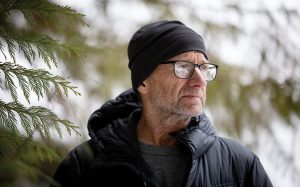
We’re writing a hybrid musical, Whitebark!, about the need for Montanans to stay connected in these turbulent times of hosting ever-increasing numbers of newcomers: obviously, not the first time this has happened. To hold on to the four distinct seasons — one of the things that helps make Montana, Montana. The forest at Black Ram can be a Climate Refuge, the nation’s first, dedicated to long-term safe storage of carbon in the simplest form — ancient trees — instead of just another giant dusty clearcut. We’ll be premiering in September 2024, along with a climate aid music festival in Montana. In the meantime, the guitar will move around the state, playing and learning herself the songs we love; inspiring us to imagine something new, from something so incredibly old.
We’re doing everything we can to ensure the ancient forest that gave us the guitar is still around to hear it. One more year, after a thousand. Call it a thousand and one. Be ready to hear what the old forest sounds like.




Melanie Maganias
Posted at 16:21h, 11 JuneIt was so interesting and informative to shoot this story! Rick Bass, with The Montana Project, had a great idea to create a guitar from a fallen ancient spruce in the Yaak. What you can’t ever really feel is the sound of this incredible guitar that master Luthier Kevin Kopp created. I was lucky enough to hear it sing on several occasions, I even had the honor of transporting it, which by the way made me feel like a rock star when I checked in the hotel with it. I learned a little bit about the Yaak, with Rick telling me stories of the forest, chatted with musicians about how wonderful it is to play the guitar, and learned how guitars are made during a personal tour of Kevin’s shop. I love being able to photograph unique stories of people and their passions for the Big Sky Journal!